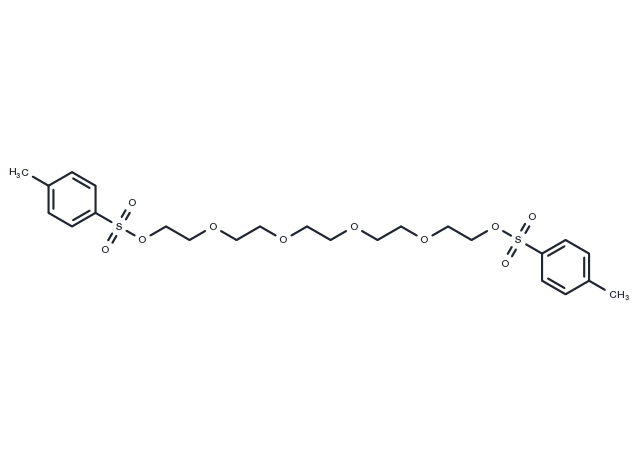Powder: -20°C for 3 years | In solvent: -80°C for 1 year


Pentaethylene glycol di(p-toluenesulfonate) (Penta(ethylene glycol) bis(p-toluenesulfonate)) is a PEG-based PROTAC linker. Pentaethylene glycol di(p-toluenesulfonate) can be used in the synthesis of PROTACs.

| Pack Size | Availability | Price/USD | Quantity |
|---|---|---|---|
| 500 mg | In stock | $ 39.00 |

| Description | Pentaethylene glycol di(p-toluenesulfonate) (Penta(ethylene glycol) bis(p-toluenesulfonate)) is a PEG-based PROTAC linker. Pentaethylene glycol di(p-toluenesulfonate) can be used in the synthesis of PROTACs. |
| In vitro | PROTACs contain two different ligands connected by a linker; one of them is a ligand for an E3 ubiquitin ligase and the other one is for the target protein. PROTACs exploit the intracellular ubiquitin-proteasome system to selectively degrade target proteins[1]. |
| Synonyms | Penta(ethylene glycol) bis(p-toluenesulfonate), Bis-Tos-PEG5 |
| Molecular Weight | 546.65 |
| Formula | C24H34O10S2 |
| CAS No. | 41024-91-3 |
Powder: -20°C for 3 years | In solvent: -80°C for 1 year
You can also refer to dose conversion for different animals. More
bottom
Please see Inhibitor Handling Instructions for more frequently ask questions. Topics include: how to prepare stock solutions, how to store products, and cautions on cell-based assays & animal experiments, etc.
Pentaethylene glycol di(p-toluenesulfonate) 41024-91-3 Others PROTAC PROTAC Linker Pentaethylene glycol di(ptoluenesulfonate) Penta(ethylene glycol) bis(p-toluenesulfonate) Pentaethylene glycol di(p toluenesulfonate) Inhibitor Bis-Tos-PEG5 PROTAC Linkers inhibit inhibitor
